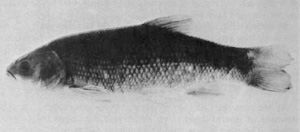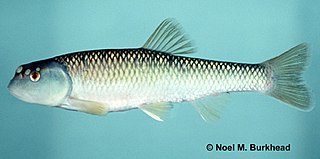
The thicktail chub was a type of minnow that inhabited the lowlands and weedy backwaters of the Sacramento and San Joaquin Rivers in the Central Valley of California. It was once abundant in lowland lakes, marshes, ponds, slow-moving stretches of river, and, during years of heavy run-off, the surface waters of San Francisco Bay. The thicktail chub was one of the most common fish in California. Within Native American middens it represented 40% of the fish.
The tui chub is a cyprinid fish native to western North America. Widespread in many areas, it is an important food source for other fish, including the cutthroat trout.

The northern leatherside chub is a cyprinid fish of western North America.

The bonytail chub or bonytail is a cyprinid freshwater fish native to the Colorado River basin of Arizona, California, Colorado, Nevada, New Mexico, Utah and Wyoming in the southwestern United States; it has been extirpated from the part of the basin in Mexico. It was once abundant and widespread in the basin, its numbers and range have declined to the point where it has been listed as endangered since 1980 (ESA) and 1986 (IUCN), a fate shared by the other large Colorado basin endemic fish species like the Colorado pikeminnow, humpback chub, and razorback sucker. It is now the rarest of the endemic big-river fishes of the Colorado River. There are 20 species in the genus Gila, seven of which are found in Arizona.
The sturgeon chub is a species of ray-finned minnow fish in the family Cyprinidae. It is found only in the United States. It is a species of concern in the Charles M. Russell National Wildlife Refuge in Montana.
Macrhybopsis, the blacktail chubs, is a genus of cyprinid fish that are found in North America. There are currently 12 species in this genus.
The sicklefin chub is a species of ray-finned minnow fish in the family Cyprinidae. It is found only in the United States. It is one of the 324 fish species found in Tennessee, and is a species of concern in the Charles M. Russell National Wildlife Refuge in Montana.
The Sandhills chub is a species of freshwater fish in the family Cyprinidae of order Cypriniformes. There are 4 species of Semotilus, 2 of which occur in South Carolina. This fish is found only in North Carolina and South Carolina. The Sandhills chub is predominately found in the Carolina Sandhills and some areas of Cape Fear, Pee Dee and Santee river drainages. It is characterized by its robust body, large head and lack of a dark blotch or smudge on their dorsal fin which is present on the closely related Creek Chub. The Sandhills chub has fine scales, a pinkish body and can be up to 9.4 inches.
The Virgin chub or the Virgin River chub is a medium-sized, silvery minnow, generally less than 15 cm long and reaching lengths of 25 cm. The back, breast, and part of the belly are embedded with small scales, naked in some individuals. The length of the head divided by the depth of the caudal peduncle typically results in a ratio of 4.0 to 5.0. The scales are typically lacking basal radii or are with extremely faint lines.

The speckled chub is a species of freshwater fish in the family Cyprinidae of the order Cypriniformes, which also includes carps, suckers, and loaches.
The lined chub is a species of freshwater ray-finned fish from the carp and minnow family, Cyprinidae. It is endemic to the United States of America where it occurs in the Coosa and Tallapoosa River systems in the states of Alabama, Georgia and Tennessee. It can be found in small to medium-sized streams which have pools and riffles over sand, gravel, or rubble beds; especially in gently flowing to quiet, clear water close to riffles and vegetation. It feeds on chironomid larvae and pupae, and larger aquatic insects It is threatened by canalisation of its native rivers and by siltation caused by logging.
The silver chub is a species of freshwater fish of the family Cyprinidae found in North America.

The bluehead chub is a cyprinid native to North America. Its name is due to its appearance, as breeding males have a blue head. Adult bluehead chubs are, on average, between 70 and 160 mm in length. They have a robust body with uniformly large scales. The scales are present on the belly and breast. They have a pored body, a weakly falcate pectoral fin, and pharyngeal teeth. They have a large mouth, small eyes, and a terminal barbel. Other characteristics include a darkened lateral band, spot on the caudal fin, and red coloration of the fins and iris of the eyes. They have 40 lateral line scales and 8 anal rays. The bluehead chub is a freshwater fish, and lives in pools, rivers, and streams. They feed on insects and plants.
The southern leatherside chub is a species of freshwater ray-finned fish from the family Cyprinidae, the carps and minnows. It is endemic to Utah in the United States. It is found in slow-flowing pools and backwaters, usually over substrates consisting of mud or sand, of creeks and small to medium-sized rivers. Within Utah, this species is found on the southeastern margins of the Bonneville Basin; it has been recorded from the American Fork, Provo River, and Spanish Fork drainages of the Utah Lake Basin and the San Pitch River, East Fork Sevier River, Beaver River, and the lower, middle, and upper Sevier River drainages of the Sevier River Basin; it has now apparently been extirpated from the Provo River at Utah Lake and from the Beaver River. It is threatened by the fragmentation of its habitat caused by water abstraction for irrigation, damming, urbanization, and poor farming practices. It is also threatened by introduced predatory fish such as the brown trout.

The shoal chub is a freshwater ray-finned fish in the family Cyprinidae, the carps and minnows. It occurs in Mississippi River drainages from eastern Ohio to southern Minnesota and Nebraska south to Louisiana. Its preferred habitat is sand and gravel runs of small to large rivers.
The burrhead chub is a freshwater ray-finned fish in the family Cyprinidae, the carps and minnows. It occurs in the Colorado, Guadalupe, and San Antonio river drainages in Texas. Its preferred habitat is sand and gravel runs of small to large rivers.
The peppered chub, also known as the Arkansas River speckled chub, is a freshwater ray-finned fish in the family Cyprinidae, the carps and minnows. It historically occurred throughout the Arkansas River drainage, but today is found in the Ninnescah River, a small portion of the Arkansas River in Kansas and the South Canadian River between Ute and Meredith reservoirs in New Mexico and Texas. Its preferred habitat is shallow channels of large, permanently flowing, sandy streams, and prefers currents over a substrate of clean, fine sand.






